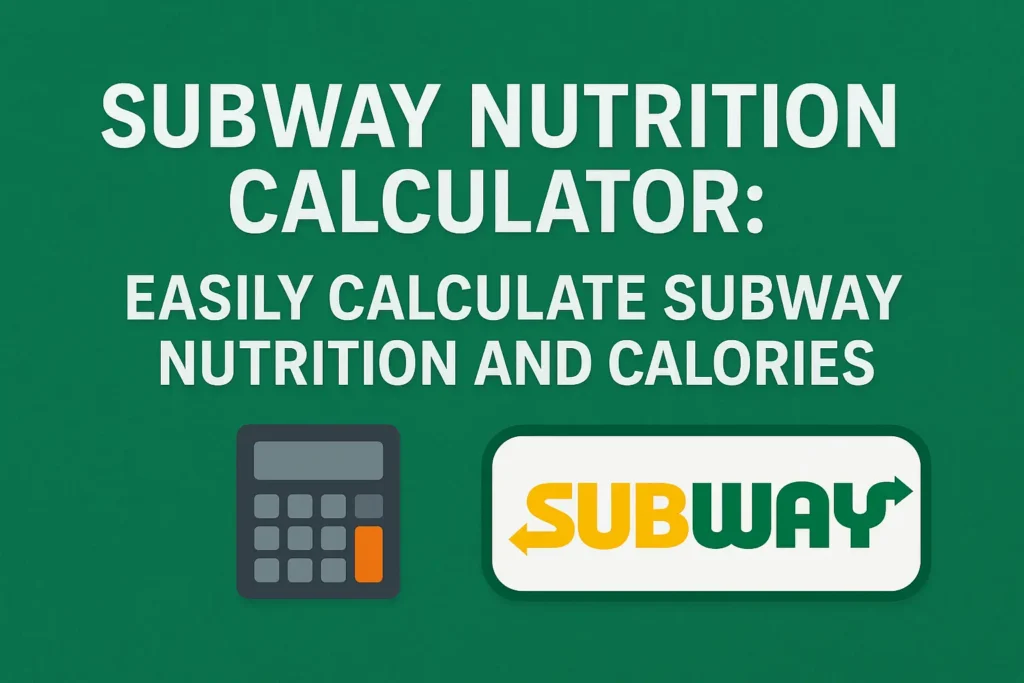
When you visit Subway, the first thing that comes to mind is the variety of fresh sandwiches, salads, and wraps. But if you are someone who likes to track calories or keep an eye on nutrition, it can sometimes feel confusing. How many calories are in a 6-inch sandwich? What about a footlong? How many carbs, protein, or fats are in your favorite meal? That’s where the Subway nutrition calculator becomes your best tool.
This blog will guide you step by step on how to use the Subway nutrition calculator, why it’s important, and how you can use it for healthy eating. We will also compare Subway’s nutrition tool with other popular nutrition calculators like Chick-fil-A, Panda Express, Domino’s, and more.
Why Use the Subway Nutrition Calculator?
In today’s fast-paced life, eating out is common, but staying healthy can be tricky. Many people struggle with balancing tasty food and nutrition. Subway is known for its “Eat Fresh” slogan, but even healthy food can become unhealthy if not chosen carefully.
For example:
- A simple Veggie Delight Sandwich may have low calories, but once you add cheese, extra sauces, and footlong bread, calories can quickly increase.
- A Chicken Teriyaki Sandwich may sound healthy, but if you don’t check the sugar content in sauces, you might consume more than expected.
By using the subway nutrition calculator, you can:
- Track calories before ordering.
- Customize your sandwich to fit your diet.
- Make healthier choices without guessing.
How the Subway Nutrition Calculator Works
The Subway nutrition calculator US is an online tool provided by Subway on its website and app. It lets you build your sandwich virtually and calculates nutrition instantly.
Here’s how to use it:
- Choose your bread – 6-inch or footlong, wheat, multigrain, Italian, or flatbread.
- Pick a protein – chicken, turkey, tuna, meatballs, or plant-based options.
- Add cheese – American, cheddar, mozzarella, or skip if you want fewer calories.
- Add veggies – lettuce, tomato, cucumber, onion, spinach, peppers.
- Select sauces – mayonnaise, chipotle southwest, honey mustard, ranch, or oil and vinegar.
- Finalize your sandwich – toasted or fresh.
Once you select these options, the subway sandwich nutrition calculator shows details like:
- Total calories
- Carbohydrates
- Proteins
- Fats
- Sugars
- Sodium
This helps you see exactly how healthy (or unhealthy) your Subway sandwich is.
Benefits of Tracking Subway Nutrition
Using the nutrition calculator Subway offers multiple benefits:
Helps with Weight Management
If you’re trying to lose or gain weight, knowing calories is essential. A 6-inch sandwich might have 250–400 calories, while a footlong could go up to 800–1000 calories depending on toppings.
Supports Fitness Goals
Athletes and gym-goers often track protein intake. The subway nutrition calories calculator helps find high-protein options like chicken breast sandwiches without hidden calories.
Manages Health Conditions
People with diabetes or high blood pressure can use the calculator to avoid too much sugar or sodium.
Easy Meal Customization
Instead of guessing, you can create a meal that perfectly fits your diet.
Popular Subway Sandwich Examples with Calories
Here are some examples of Subway sandwiches with approximate calorie counts (using the subway sandwiches nutrition calculator):
- Veggie Delight (6-inch): ~230 calories
- Turkey Breast (6-inch): ~280 calories
- Chicken Teriyaki (6-inch): ~370 calories
- Meatball Marinara (6-inch): ~480 calories
- Tuna Sandwich (6-inch): ~470 calories
A footlong version almost doubles these numbers, so tracking with the subway nutrition calculator is important.
Subway Nutrition Calculator vs Other Nutrition Calculators
While Subway offers its own tool, many other fast-food chains also provide calculators. Let’s compare:
- Cava Nutrition Calculator – helps track Mediterranean meals like bowls and wraps.
- Chick-fil-A Nutrition Calculator – used for chicken sandwiches, nuggets, and sauces.
- Domino’s Nutrition Calculator – tracks pizza, sides, and desserts.
- Panda Express Nutrition Calculator – useful for Asian dishes like orange chicken and fried rice.
- Moe’s Nutrition Calculator – for burritos, tacos, and bowls.
- Wawa Nutrition Calculator – covers hoagies, salads, and smoothies.
- Qdoba Nutrition Calculator – tracks Mexican-inspired meals.
Still, the subway sandwich nutrition calculator stands out because Subway meals are highly customizable, and no two sandwiches are the same.
How to Calculate Subway Nutrition Manually
Sometimes, you may not have internet access. In that case, here’s a simple way to calculate Subway nutrition manually:
- Check the official Subway menu chart (available in stores).
- Add bread calories (around 200–250 for 6-inch).
- Add protein calories (chicken ~120, tuna ~250, meatball ~300).
- Add cheese (around 50–80).
- Add sauces (chipotle ~100, mayonnaise ~90, honey mustard ~60).
- Add veggies (almost calorie-free, under 20).
This gives a rough estimate similar to the subway nutrition calculator US.
Tips for Making Healthier Subway Choices
- Choose 6-inch bread instead of footlong to cut calories.
- Pick lean proteins like chicken breast or turkey.
- Add extra veggies for fiber and fullness.
- Go easy on sauces like mayonnaise and chipotle southwest.
- Try oil and vinegar for a lighter dressing.
- Skip cheese if you’re reducing fat intake.
These small changes, guided by the subway nutrition calories calculator, can make a big difference.
Subway Nutrition for Kids and Families
The subway nutrition calculator isn’t just for fitness lovers—it’s also helpful for families. Parents can track what their kids are eating. Subway even offers kids’ meals with apple slices and low-fat milk for healthier options.
Using the Subway Nutrition Calculator for Meal Planning
If you’re planning weekly meals, you can use the subway nutrition calculator US to:
- Compare different sandwiches.
- Plan calorie intake for lunch or dinner.
- Mix and match meals with salads and wraps.
For example, eating a Veggie Delight for lunch and a Chicken Teriyaki for dinner balances calories and protein.
Final Thoughts
The subway nutrition calculator is more than just a digital tool. It’s a guide to making smarter choices at one of the world’s most popular sandwich chains. Whether you’re tracking calories for weight loss, building muscle with high-protein meals, or managing health conditions, this calculator ensures you stay informed.
By learning to use the subway nutrition calculator effectively, you can enjoy your favorite sandwiches without guilt and maintain a balanced lifestyle.
So next time you’re at Subway, don’t just order blindly—take a minute to calculate your meal. Your body will thank you later!
FAQs
How to calculate nutrition facts for a recipe?
To calculate nutrition facts for a recipe, write down all the ingredients with their amounts. Then, check the calories, protein, fat, carbs, and other nutrients for each ingredient. Add them together, and divide by the number of servings to find the nutrition per serving.
How to calculate nutrition facts label?
A nutrition facts label is made by listing each ingredient’s nutrients and totaling them. After that, the data is shown in a standard format with calories, fat, protein, carbs, sugar, fiber, and vitamins. Tools like the Subway Nutrition Calculator or recipe nutrition calculators online can generate labels easily.
How to calculate nutritional value of a recipe?
The nutritional value of a recipe is found by checking each ingredient’s data (from food databases or packaging). Once you know the totals, divide by servings. For example, if your recipe has 800 calories and makes 4 servings, each serving has 200 calories.
How do you calculate nutritional information?
Nutritional information is calculated by using food databases (like USDA) or nutrition calculators. You need to add up calories, fats, proteins, carbs, and other nutrients from every ingredient and then divide by servings.
How to calculate a nutrition label?
To make a nutrition label, you must collect nutrient data for each ingredient, total them up, and format it into the standard nutrition facts box. Online calculators can help you quickly design one.
How to calculate nutrition facts for homemade food?
For homemade food, list all ingredients and their amounts, then look up nutrition data for each (from packaging or databases). Add them together, then divide by the number of portions to know per-serving nutrition.
How do you calculate nutrition facts?
Nutrition facts are calculated by adding the calorie and nutrient values of every ingredient in your recipe. Then, the result is divided into servings so you can know the exact amount of energy and nutrients per serving.
How to calculate nutrition facts for a recipe?
Take each ingredient, look up its nutrition profile, and multiply by the amount you used. After combining all nutrients, divide by the number of servings. That’s your recipe’s nutrition facts per portion.
How to calculate nutrition facts from a recipe?
To calculate nutrition from a recipe, gather the total calories, protein, fat, and carbs from each ingredient, sum them up, and then divide by the number of servings. Tools like Subway Nutrition Calculator can make this process much easier.
How to calculate nutrition of a recipe?
The nutrition of a recipe is calculated by summing up nutrients from each ingredient. For example, if one egg has 70 calories and bread has 80, then your egg sandwich has 150 calories in total.
How to calculate nutritional information?
You can calculate nutritional information by using food labels, USDA databases, or nutrition calculators. Just add up nutrients from all ingredients and divide by servings.
How to calculate recipe nutrition?
Recipe nutrition is calculated by adding the nutrition values of every ingredient used. Then, divide the totals by the number of servings. This gives per-portion calories, protein, fat, and carbs.
